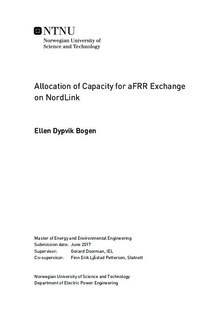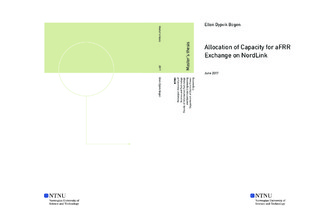| dc.description.abstract | A growing share of intermittent power production leads to challenges in power system balancing and requires improvement of system regulation capability. Cross-zonal exchange of balancing services is a step towards harmonized European balancing markets and an instrument to meet these challenges. In order to exchange balancing services, reservation of cross-zonal capacity(CZC) should be executed. The allocation of CZC for exchange of balancing services should maximize social surplus.
A market-based reservation model is one of the methods, described by the Network Code on Electricity Balancing, in which socioeconomic efficiency of the reservation of CZC can be demonstrated. In a market-based reservation model the marginal value of the CZC in the different markets are compared, to decide on a reservation volume that maximizes social surplus.
Simulations with case studies in a marked-based reservation model was performed,with the aim of quantifying the possibility of cross-zonal automatic frequency restoration reserves(aFRR) capacity exchange. The simulations in the marked-based reservation model was performed with weekly auctions on aFRR.
Six different case studies were developed; three historical case studies and three future case studies. Each of the case studies was developed by generating aFRR bid curves, using a regression model and historical aFRR bid prices. Historical Day-ahead market(DAM) prices were used for the historical case studies, while the future case studies used DAM prices simulated in Samlast and BID.
Socioeconomic benefit was demonstrated for all the case studies when simulated in the market-based reservation model. Germany was the main provider of aFRR for all the case studies. The latter result contradicts the expectations provided in a qualitative analysis of the thesis, in which Norway was considered to have a competitive advantage in providing aFRR.
The main reason for the simulation results appear to be non-representative inputs of aFRR bids. The aFRR market designs in Norway and Germany are too different, resulting in the distribution of the cost of offering aFRR appears to be shifted in opposite direction between energy and capacity bids.
Therefore, a sensitivity analysis was conducted to study the effect of market development in the direction expected in the qualitative assessment. The results showed that if Norwegian aFRR capacity bids became cheaper than German aFRR capacity bids, increasing the price difference between the countries leads to an increasing socioeconomic benefit. | |

